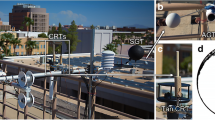Abstract
To properly simulate the condensation process and design a water recovery system from condensation of atmospheric water vapour on a surface maintained below the dew point by radiative heat loss from the surface to night sky, an accurate estimation of the effective sky temperature is required. To estimate the effective night sky temperature, an experimental system consisting of a series of metal plates embedded on a heat transfer panel, a weather station and a control system was used. The results obtained from theoretical analyses and preliminary experiments are presented and discussed. A special emphasis is given to a mathematical solution of the system of equations that need to be solved to obtain the effective sky temperature. It is shown that although the system of equations works well for the direct heat transfer problem, there is a serious difficulty to solve the inverse heat transfer problem to retrieve the desired parameters.







Similar content being viewed by others
References
Sciperio A Science Revolution (2005) http://www.sciperio.com/watertech/water-from-air.html consulted, 17 Sept 2005
Nabbia G (1961) The problem of obtaining water from the air. In: Proceedings of the conference on solar and aeolian energy, Part V. pp 33–46
Sultan A (2004) Absorption/regeneration non-conventional system for water extraction from atmospheric air. Renew Energy 29:1515–1535
Berdahl P, Fromberg R (1982) The thermal radiance of clear skies. Sol Energy 29:299–314
Khedari J, Waewsak J, Thepa S, Hirunlabh J (2000) Field investigation of night radiation cooling under tropical climate. Renew Energy 20:183–193
Ali AHHA (2007) Passive cooling of water at night in uninsulated open tank in hot arid areas. Energy Convers Manag 48:93–100
Cooper PI, Christie EA, Dunkle RV (1981) A method of measuring sky temperature. Sol Energy 26:153–159
Philipona R, Frohlich C, Betz C (1995) Characterization of pyrgeometers and the accuracy of atmospheric long wave radiation measurements. Appl Opt 34:1598–1605
Ji Q, S-Ch Tsay (2000) On the dome effect of Eppley pyrgeometers and pyranometers. Geophy Res Lett 27:971–974
Enz JW, Klink JC, Baker DG (1975) Solar radiation effects on pyrgeometer performance. J Appl Meteor 19:1297
Reda I, Hickey JR, Stoffel T, Myers D (2002) Pyrgeometer calibration at the national renewable energy laboratory (NREL). J Atmos Solar-Terrest Phy 64:1623–1629
Berdahl P, Fromberg R (1982) The thermal radiance of clear skies. Sol Energy 29:299–314
Stoffel T, Reda I, Hickey J, Dutton E, Michalsky J (2006) Pyrgeometer calibrations for atmospheric radiation measurement program: updated approach, 16th ARM science team meeting proceedings, Albuquerque, NM, 27–31 Mar 2006
Mills AF (1999) Heat transfer, 2nd edn. Prentice-Hall Inc, Upper Saddle River
Dhirendra K, Robert B, Jack P (1994) Effects of atmospheric emissivity on clear sky temperatures. Atmos Environ 29:2201–2204
Chen B, Maloney J, Clark D, Mei WN, Kasher J (2009) Measurement of night sky emissivity in determining radiant cooling from cool storage roofs and roof bonds. Passive solar research group University of Nebraska. http://www.ceen.unomaha.edu/solar/documents/SOL_29.pdf, consulted 15 Jan 2009
Gliah OR (2008) Water extraction from the atmosphere. MASc thesis. University of Ottawa, Ottawa, Canada
Armenta-Déu C, Donaire T, Hernando J (2003) Thermal analysis of a prototype to determine radiative cooling thermal balance. Renew Energy 28:1105–1120
Acknowledgments
The authors gratefully acknowledge the financial support for this project provided by the Natural Science and Engineering Research Council of Canada.
Author information
Authors and Affiliations
Corresponding author
Rights and permissions
About this article
Cite this article
Gliah, O., Kruczek, B., Etemad, S.G. et al. The effective sky temperature: an enigmatic concept. Heat Mass Transfer 47, 1171–1180 (2011). https://doi.org/10.1007/s00231-011-0780-1
Received:
Accepted:
Published:
Issue Date:
DOI: https://doi.org/10.1007/s00231-011-0780-1




